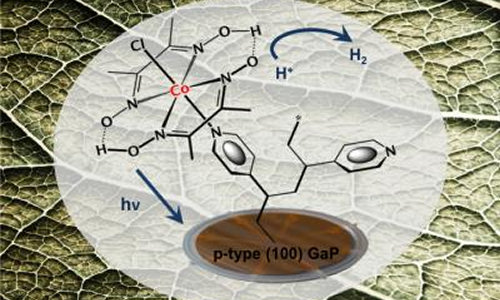There’s promising news from the front on efforts to produce fuels through artificial photosynthesis. A new study by Berkeley Lab researchers at the Joint Center for Artificial Photosynthesis (JCAP) shows that nearly 90-percent of the electrons generated by a hybrid material designed to store solar energy in hydrogen are being stored in the target hydrogen molecules.
Interfacing the semiconductor gallium phosphide with a cobaloxime catalyst provides an inexpensive photocathode for bionic leaves that produce energy-dense fuels from nothing more than sunlight, water and carbon dioxide. Credit: Gary Moore, Berkeley Lab
Gary Moore, a chemist and principal investigator with Berkeley Lab’s Physical Biosciences Division, led an efficiency analysis study of a unique photocathode material he and his research group have developed for catalyzing the production of hydrogen fuel from sunlight. This material, a hybrid formed from interfacing the semiconductor gallium phosphide with a molecular hydrogen-producing cobaloxime catalyst, has the potential to address one of the major challenges in the use of artificial photosynthesis to make renewable solar fuels.
“Ultimately the renewable energy problem is really a storage problem,” Moore says. “Given the intermittent availability of sunlight, we need a way of using the sun all night long. Storing solar energy in the chemical bonds of a fuel also provides the large power densities that are essential to modern transport systems. We’ve shown that our approach of coupling the absorption of visible light with the production of hydrogen in a single material puts photoexcited electrons where we need them to be, stored in chemical bonds.”
Moore is the corresponding author of a paper describing this research in the journal Physical Chemistry Chemical Physics titled “Energetics and efficiency analysis of a cobaloxime-modified semiconductor under simulated air mass 1.5 illumination.” Co-authors are Alexandra Krawicz and Diana Cedeno.
Bionic leaves that produce energy-dense fuels from nothing more than sunlight, water and atmosphere-warming carbon dioxide, with no byproducts other than oxygen, represent an ideal sustainable energy alternative to fossil fuels. However, realizing this artificial photosynthesis ideal will require a number of technological breakthroughs including high performance photocathodes that can catalyze fuel production from sunlight alone.
Last year, Moore and his research group at JCAP took an important step towards the photocathode goal with their gallium phosphide/cobaloxime hybrid. Gallium phosphide is an absorber of visible light, which enables it to produce significantly higher photocurrents than semiconductors that only absorb ultraviolet light. The cobaloxime catalyst is also Earth-abundant, meaning it is a relatively inexpensive replacement for the highly expensive precious metal catalysts, such as platinum, currently used in many solar-fuel generator prototypes.
“The novelty of our approach is the use of molecular catalytic components interfaced with visible-light absorbing semiconductors,” Moore says. “This creates opportunities to use discrete three-dimensional environments for directly photoactivating the multi-electron and multi-proton chemistry associated with the production of hydrogen and other fuels.”
The efficiency analysis performed by Moore and his colleagues also confirmed that the light-absorber component of their photocathode is a major bottleneck to obtaining higher current densities. Their results showed that of the total number of solar photons striking the hybrid-semiconductor surface, measured over the entire wavelength range of the solar spectrum (from 200 to 4,000 nanometers) only 1.5-percent gave rise to a photocurrent.
“This tells us that the use of light absorbers with improved spectral coverage of the sun is a good start to achieving further performance gains, but it is likely we will also have to develop faster and more efficient catalysts as well as new attachment chemistries. Our modular assembly method provides a viable strategy to testing promising combinations of new materials,” Moore says.
“Efficiency is not the only consideration that should go into evaluating materials for applications in solar-fuel generator technologies. Along with the durability and feasible scalability of components, the selectivity of photoactivating a targeted reaction is also critical. This is where molecular approaches offer significant opportunities, especially in catalyzing complex chemical transformations such as the reduction of carbon dioxide.”
Story Source:
The above story is based on materials provided by Lawrence Berkeley National Laboratory.





